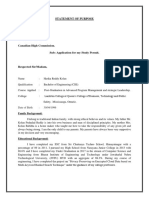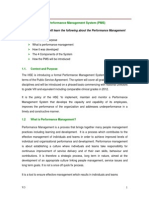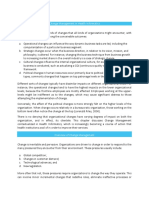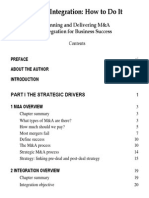0 ratings0% found this document useful (0 votes)
107 viewsChapter 8
Chapter 8
Uploaded by
ahmadThe document discusses models and strategies for improving performance at the organizational and individual levels, including identifying critical success factors and objectives, developing high-performance cultures through clear expectations and accountability, and addressing underperformance through root cause analysis and targeted solutions. Key aspects of performance management involve setting goals, monitoring progress, providing feedback, and continually updating objectives based on evaluation results.
Copyright:
© All Rights Reserved
Available Formats
Download as PPT, PDF, TXT or read online from Scribd
Chapter 8
Chapter 8
Uploaded by
ahmad0 ratings0% found this document useful (0 votes)
107 views26 pagesThe document discusses models and strategies for improving performance at the organizational and individual levels, including identifying critical success factors and objectives, developing high-performance cultures through clear expectations and accountability, and addressing underperformance through root cause analysis and targeted solutions. Key aspects of performance management involve setting goals, monitoring progress, providing feedback, and continually updating objectives based on evaluation results.
Original Description:
performance Management
Copyright
© © All Rights Reserved
Available Formats
PPT, PDF, TXT or read online from Scribd
Share this document
Did you find this document useful?
Is this content inappropriate?
The document discusses models and strategies for improving performance at the organizational and individual levels, including identifying critical success factors and objectives, developing high-performance cultures through clear expectations and accountability, and addressing underperformance through root cause analysis and targeted solutions. Key aspects of performance management involve setting goals, monitoring progress, providing feedback, and continually updating objectives based on evaluation results.
Copyright:
© All Rights Reserved
Available Formats
Download as PPT, PDF, TXT or read online from Scribd
Download as ppt, pdf, or txt
0 ratings0% found this document useful (0 votes)
107 views26 pagesChapter 8
Chapter 8
Uploaded by
ahmadThe document discusses models and strategies for improving performance at the organizational and individual levels, including identifying critical success factors and objectives, developing high-performance cultures through clear expectations and accountability, and addressing underperformance through root cause analysis and targeted solutions. Key aspects of performance management involve setting goals, monitoring progress, providing feedback, and continually updating objectives based on evaluation results.
Copyright:
© All Rights Reserved
Available Formats
Download as PPT, PDF, TXT or read online from Scribd
Download as ppt, pdf, or txt
You are on page 1of 26
PERFORMANCE MANAGEMENT
DR. HAIDER SHAH
Senior Assistant Professor
Bahria University Islamabad
Improving Performance
The improvement of performance is
a fundamental part of the continuous
process of performance
management.
IMPROVING PERFORMANCE AT
THE ORGANIZATIONAL LEVEL
It is appealing for managements to
say that poor performance is always
someone else’s fault, never theirs.
But Poor Performance may be a
result of:
Inadequate leadership,
Bad Management
Defective systems of work.
IMPROVING PERFORMANCE AT
THE ORGANIZATIONAL LEVEL
What are the reasons of failure?
The failure can be at the top of the
organization because well-defined and
clear expectations for superior
performance have not been established
and followed.
And effective processes of performance
management can provide a valuable
means of communicating these
expectations.
THE PROBLEMS AT
MANAGERIAL LEVEL
Managers, as Schaffer points out,
sometimes use a variety of psychological
mechanisms as described below for
avoiding the unpleasant truth that
performance gaps exist:
Evasion through rationalization
Reliance on procedures (‘Let there be
performance-related pay, or
performance management’)
THE PROBLEMS AT
MANAGERIAL LEVEL
Attacks that Skirt The Target?
(attempt to ignore; avoid) Managers
may set tough goals and insist that
they are achieved but still fail to
produce a sense of accountability in
employees or provide the support
required to achieve the goals.
DEALING WITH THE PROBLEM
OVERALL STRATEGY
The following strategy for action was
suggested by Schaffer to deal with
these problems and get better
results:
Select the goal: Start with an urgent
problem
Specify the minimum expectations of
results
Communicate expectations clearly
DEALING WITH THE PROBLEM
OVERALL STRATEGY
Allocate responsibility
Expand and extend the process
(Once success has been achieved set
new or extend the goal)
DEALING WITH THE PROBLEM –
HUMAN RESOURCE IMPROVEMENT
Human resource improvement (HRI)
is defined as?
American Society for Training and
Development define as
‘the systematic process of articulating
organization goals, relating those goals to
the performance of people, uncovering the
reasons for performance gaps,
implementing solutions, managing change
and evaluating the direct and indirect
results’
HRI
HRI is results based, driven by business
and performance needs. It works in the
following sequence:
Identify an organizational problem.
Articulate a relationship between the
problem and human performance.
Determine a quantifiable performance
gap between the desired level of
performance and the actual level of
performance
HRI
Conduct an analysis of the root
causes to reveal the reasons for the
performance gap.
Implement a series of solutions to
address the root causes.
NEXT WHAT?
TOP MANAGEMENT LEVERS FOR
IMPROVING PERFORMANCE.
Develop a high-performance culture
The characteristics of such a culture
are:
l a clear line of sight exists between
the strategic aims of the organization
and those of its departments and its
staff at all levels;
TOP MANAGEMENT LEVERS FOR
IMPROVING PERFORMANCE
management defines what it requires
in the shape of performance
improvements, sets goals for success
and monitors performance to ensure
that the goals are achieved.
Leadership from the top that
engenders a shared belief in the
importance of continuous
improvement;
TOP MANAGEMENT LEVERS FOR
IMPROVING PERFORMANCE
focus on promoting positive
attitudes that result in a committed,
motivated and engaged workforce.
Sears performance model
The Sears performance model The
means by which a business achieves
high performance was modelled by
Sears, the US retailing company.
This model emphasizes the
importance of employee attitude and
behaviour in making the firm ‘a
compelling place to shop’ and
ultimately ‘a compelling place to
invest’.
Sears Performance Model
MODEL OF PERFORMANCE MANAGEMENT
AT THE ORGANIZATIONAL LEVEL
Critical Success Factors
Product Development
Market Development
Process Innovation
Customer Service
Human Resources
Asset Utilization
Strategies
Strategies may be set out under such
headings as:
Corporate strategy
Marketing
Operations
Research and Development
Human resources
Finance
IT
Objectives
Financial
Product/Market development
Operational development
Performance improvement
Growth
People
IMPROVING TEAM PERFORMANCE
Team performance reviews
General review
Work review
Group problem-solving
Updating of objectives and work
plans
IMPROVING INDIVIDUAL PERFORMANCE
The University of Bath People and
Performance Model (Purcell and
colleagues, 3) states that
Increasing Ability
Increasing Motivation
Increasing Opportunity
The five basic steps in
managing underperformers
Identify and agree the problem
Establish the reason(s) for the
shortfall
Decide and agree on the action
required
Resource the action
Monitor and provide feedback
References
Performance Management, Key Strategies And
Practical Guidelines, 3rd Edition by Michael
Armstrong
People and Performance: The Best by Peter
Drucker on Management 1st Edition published by
Routledge
Performance Management: by Herman Aguinis
Balanced Scorecard Step by step: Maximizing
Performance and Maintaining Results by Paul R.
Niven
Activity
Write down the application of model
of performance management at the
organizational level for any real world
example of an organization.
MODEL OF PERFORMANCE MANAGEMENT
AT THE ORGANIZATIONAL LEVEL
You might also like
- Cmbok6 Changes From Cmbok5 PDFDocument9 pagesCmbok6 Changes From Cmbok5 PDFCarlos RubinoNo ratings yet
- Statement of PurposeDocument3 pagesStatement of PurposeSharmaRubina100% (3)
- Developing Human Service Leaders 1st Edition Harley Mcclaskey Test BankDocument8 pagesDeveloping Human Service Leaders 1st Edition Harley Mcclaskey Test Bankrachelloweopizkbjnft100% (16)
- 1 - 2 - Still in Search of Strategic Human Resource Management A Review and Suggestions For Future Research With China As An ExampleDocument30 pages1 - 2 - Still in Search of Strategic Human Resource Management A Review and Suggestions For Future Research With China As An Examplemonicaliu2008No ratings yet
- Performance Appraisal Policy of The Maldives Civil ServiceDocument8 pagesPerformance Appraisal Policy of The Maldives Civil ServiceShiura AbdulrahmanNo ratings yet
- Managing Performance and Reward (HURM09002 - 01)Document18 pagesManaging Performance and Reward (HURM09002 - 01)Md Riyaz MostanNo ratings yet
- (M) David - sm15 - Inppt - 03Document13 pages(M) David - sm15 - Inppt - 03Saurabh Kumar GautamNo ratings yet
- Organizational Theory, Design, and Change: Sixth Edition Gareth R. JonesDocument29 pagesOrganizational Theory, Design, and Change: Sixth Edition Gareth R. JonesSiswantoSiswantoNo ratings yet
- Becker, B. E., & Huselid, M. A. 1998. High Performance Work PDFDocument25 pagesBecker, B. E., & Huselid, M. A. 1998. High Performance Work PDFÁtila de AssisNo ratings yet
- Case StudyDocument4 pagesCase StudyAsad HaroonNo ratings yet
- Case Chapter 15 - Nugraheni Vita Dyana - 041724353022Document6 pagesCase Chapter 15 - Nugraheni Vita Dyana - 041724353022vidia2000No ratings yet
- Operational Readiness Review A Complete Guide - 2020 EditionFrom EverandOperational Readiness Review A Complete Guide - 2020 EditionNo ratings yet
- Teacher Capacity Development Programme Project ProposalDocument8 pagesTeacher Capacity Development Programme Project ProposalLockias ChitananaNo ratings yet
- 5 Paths To Leadership ResultsDocument18 pages5 Paths To Leadership Resultsapi-345345442No ratings yet
- What Is Performance ManagementDocument5 pagesWhat Is Performance ManagementZulaikha ShamNo ratings yet
- Cross 1988Document11 pagesCross 1988deltanueveNo ratings yet
- Performance Management ProcessDocument15 pagesPerformance Management ProcessramaakumariNo ratings yet
- CHAPTER 11 - Implementing Strategic (Resume)Document6 pagesCHAPTER 11 - Implementing Strategic (Resume)Meddy YogastoroNo ratings yet
- 7 Elements of Effective Performance ManagementDocument9 pages7 Elements of Effective Performance Managementsandeep k krishnanNo ratings yet
- Performance Management System PhilosophyDocument8 pagesPerformance Management System PhilosophyGency0511No ratings yet
- Definition of Organization Development Organisation Development Is A SystemDocument30 pagesDefinition of Organization Development Organisation Development Is A SystemAhmed Khan100% (1)
- Lesson 15Document11 pagesLesson 15Sittie Aina MunderNo ratings yet
- Human Resourse ManagementDocument16 pagesHuman Resourse ManagementBilal WaheedNo ratings yet
- Recruitment and SelectionDocument24 pagesRecruitment and SelectionMeena IyerNo ratings yet
- SNGPLDocument43 pagesSNGPLRoshan Zamir100% (2)
- Quiz 2 AnswersDocument4 pagesQuiz 2 AnswersHana Demi DeeNo ratings yet
- Difference Between: Organic MechanisticDocument27 pagesDifference Between: Organic MechanisticJo Arita SuarezNo ratings yet
- MANAGEMENT - Unit 04 - STAFFINGDocument54 pagesMANAGEMENT - Unit 04 - STAFFINGkimmiahujaNo ratings yet
- Pay Equity Internal and External Conside PDFDocument9 pagesPay Equity Internal and External Conside PDFOnline AccessNo ratings yet
- UMT Profile CompleteDocument33 pagesUMT Profile Completeusama ishfaqNo ratings yet
- Implications of Strategic Human Resource ManagementDocument3 pagesImplications of Strategic Human Resource Managementtallalbasahel67% (3)
- Identifying & Addressing The Training Needs of Just Tea: Training & Development Project ReportDocument19 pagesIdentifying & Addressing The Training Needs of Just Tea: Training & Development Project ReportSugandha SrivastavaNo ratings yet
- Explain How You Would Conduct A Job Analysis in A Company That Has Never Had Job DescriptionsDocument3 pagesExplain How You Would Conduct A Job Analysis in A Company That Has Never Had Job DescriptionsN. AzadNo ratings yet
- Chapter 5 Part 1Document29 pagesChapter 5 Part 1angelNo ratings yet
- Job Analysis and Evaluation A NovidDocument13 pagesJob Analysis and Evaluation A NovidDimas FatmalaNo ratings yet
- Employee PerformanceDocument19 pagesEmployee Performancenavya SinghNo ratings yet
- Chapter 5 SelectionDocument20 pagesChapter 5 SelectionNURUL ASYIKIN BINTI MOHAMMAD SHARIFF (BG)No ratings yet
- PERSON FOCUSED PAY PLAN - EditedDocument9 pagesPERSON FOCUSED PAY PLAN - EditedFAITHROSE NECHESA100% (1)
- Performance Appraisal & Hetero Drugs Ltd.Document78 pagesPerformance Appraisal & Hetero Drugs Ltd.Nirmala Rao100% (2)
- Strategic ManagementDocument34 pagesStrategic ManagementDewi PuspitaNo ratings yet
- OPEMANA - Wegman's CaseDocument8 pagesOPEMANA - Wegman's CaseDennyseOrlidoNo ratings yet
- Explain The Advantage of Non Financial PerfomanceDocument5 pagesExplain The Advantage of Non Financial PerfomanceIchiehara YukeidoNo ratings yet
- Performance Management Practices, Employee Attitudes and Managed PerformanceDocument24 pagesPerformance Management Practices, Employee Attitudes and Managed PerformanceMuhammad Naeem100% (1)
- Bell CurveDocument3 pagesBell CurvesaadashfaqNo ratings yet
- Formal Research Defense PPT Template by RomeDocument12 pagesFormal Research Defense PPT Template by RomeRheny BondocNo ratings yet
- HRM Final AssignmentDocument10 pagesHRM Final AssignmentAhmed SharifNo ratings yet
- Unit 2 Strategy Formulation and Defining VisionDocument30 pagesUnit 2 Strategy Formulation and Defining VisionjhonlhordslolorNo ratings yet
- Organizational Structure and Culture Report On OBPDocument29 pagesOrganizational Structure and Culture Report On OBPMary Francel AblaoNo ratings yet
- Job Template My Learnings: Job Analysis, Job Description and SpecificationDocument26 pagesJob Template My Learnings: Job Analysis, Job Description and SpecificationmitaleesirwaniNo ratings yet
- Introduction and Evolution of MGT TheoryDocument169 pagesIntroduction and Evolution of MGT TheorySimon Muteke100% (2)
- Operatons Decisions - A FrameworkDocument4 pagesOperatons Decisions - A FrameworkvivekNo ratings yet
- Case Study: Lincoln Hospital 1Document7 pagesCase Study: Lincoln Hospital 1renoyNo ratings yet
- Talent MGMTDocument30 pagesTalent MGMTAkanksha RathoreNo ratings yet
- Innovative Approaches To Supply Chain Risk Research SCM WorldDocument24 pagesInnovative Approaches To Supply Chain Risk Research SCM WorldAli Mohd100% (1)
- Noe HRM 12e PPT Ch11 AccessibleDocument43 pagesNoe HRM 12e PPT Ch11 AccessibleKarla SyNo ratings yet
- The Internal Environment: Resources, Capabilities, and Core CompetenciesDocument48 pagesThe Internal Environment: Resources, Capabilities, and Core CompetenciesBJ roxNo ratings yet
- CLDM Project Guidelines at Version 5.2, February 2017Document22 pagesCLDM Project Guidelines at Version 5.2, February 2017GPNo ratings yet
- Chapter 5 Performance AppraisalDocument20 pagesChapter 5 Performance AppraisaljuerulNo ratings yet
- APJ5Feb17 4247 1Document21 pagesAPJ5Feb17 4247 1Allan Angelo GarciaNo ratings yet
- RM Core Competency ModelDocument2 pagesRM Core Competency ModelKerry UlyateNo ratings yet
- Demand Forecasting: Concept, Significance, Objectives and FactorsDocument24 pagesDemand Forecasting: Concept, Significance, Objectives and FactorsXinger XingerNo ratings yet
- Business Model Innovation The Strategy of Business Breakthroughs, by Langdon MorrisDocument3 pagesBusiness Model Innovation The Strategy of Business Breakthroughs, by Langdon MorrisInternational Journal of Innovation ScienceNo ratings yet
- Bargaing FormsDocument5 pagesBargaing FormsahmadNo ratings yet
- History of Abnormal Psychology Chap 2Document20 pagesHistory of Abnormal Psychology Chap 2ahmadNo ratings yet
- Bargaining ProcessDocument11 pagesBargaining ProcessahmadNo ratings yet
- Collective Bargaining & Its ImportanceDocument4 pagesCollective Bargaining & Its Importanceahmad100% (2)
- Statistics For Individual Components Tested On The Questionnaire (Element Wise)Document8 pagesStatistics For Individual Components Tested On The Questionnaire (Element Wise)ahmadNo ratings yet
- Equal Employment Opportunity (Eeo) - CS&LR: Hamza KhanDocument14 pagesEqual Employment Opportunity (Eeo) - CS&LR: Hamza KhanahmadNo ratings yet
- IRLL Week 8 Disciplinary ActionDocument9 pagesIRLL Week 8 Disciplinary ActionahmadNo ratings yet
- Irll Week # 8 Chapter # 6Document6 pagesIrll Week # 8 Chapter # 6ahmadNo ratings yet
- Knowledge Skills Abilities of Security Guard by MeDocument2 pagesKnowledge Skills Abilities of Security Guard by MeahmadNo ratings yet
- Brief Note On JemDocument3 pagesBrief Note On JemahmadNo ratings yet
- Use of Results: Yes:4 No: 1 Yes:3 No: 2Document5 pagesUse of Results: Yes:4 No: 1 Yes:3 No: 2ahmadNo ratings yet
- Assignment 6Document2 pagesAssignment 6ahmadNo ratings yet
- 5 Best Organizational Structure ExamplesDocument7 pages5 Best Organizational Structure ExamplesahmadNo ratings yet
- Capital Structure DefiniationDocument6 pagesCapital Structure DefiniationahmadNo ratings yet
- Measuring Performance - Kerim Muhammet DirekciDocument12 pagesMeasuring Performance - Kerim Muhammet DirekciKerim Direkci100% (1)
- M&A Integration: How To Do ItDocument6 pagesM&A Integration: How To Do Itjeffhatch0% (1)
- Deped Order No. 32, S. 2010Document7 pagesDeped Order No. 32, S. 2010HazeDialino67% (3)
- Chapter 8Document12 pagesChapter 8Shuvo SarkarNo ratings yet
- Scor10 PDFDocument856 pagesScor10 PDFMohamad Novaldi100% (1)
- Leadership VolkswagenDocument18 pagesLeadership Volkswagenkanishka katariaNo ratings yet
- TANSIM 2022 RecruitmentDocument16 pagesTANSIM 2022 RecruitmentCody LeeNo ratings yet
- Quiz AllDocument4 pagesQuiz AllmohammedNo ratings yet
- Assignment On Leadership (OB)Document8 pagesAssignment On Leadership (OB)Monir H. Mazumder100% (1)
- United - States - Army - FM - 22-100 - 31 - August - 1999 - Part07Document29 pagesUnited - States - Army - FM - 22-100 - 31 - August - 1999 - Part07Bubo VirginianusNo ratings yet
- Jordana Wagner Leadership Inventory Outcome 2Document22 pagesJordana Wagner Leadership Inventory Outcome 2api-664984112No ratings yet
- Project CharterDocument5 pagesProject CharterSaqib KhawajaNo ratings yet
- 38 Shipboard Training For The Efficient Maritime EducationDocument7 pages38 Shipboard Training For The Efficient Maritime EducationosamaNo ratings yet
- Technology For Research 1: Review of Related Literature MatrixDocument16 pagesTechnology For Research 1: Review of Related Literature MatrixElie Noquera TorzarNo ratings yet
- HR SyllabusDocument8 pagesHR SyllabusRony_HarryNo ratings yet
- Dilshod KhaydarovDocument9 pagesDilshod Khaydarovkhaydarovdilshod9No ratings yet
- 3.0.0 FSO 13 DimensionsDocument1 page3.0.0 FSO 13 DimensionsRose LeeNo ratings yet
- Effective LeadershipDocument13 pagesEffective Leadershipmoraiskp321No ratings yet
- Strategic Cost ManagementDocument71 pagesStrategic Cost ManagementJamaica RumaNo ratings yet
- HR Practices-NADRA PakistanDocument2 pagesHR Practices-NADRA PakistanImran Anjum100% (1)
- NEW: Customize Your Professional Certificate To Your HR Career GoalsDocument2 pagesNEW: Customize Your Professional Certificate To Your HR Career GoalsAriane VergaraNo ratings yet
- Strategic Planning GuidebookDocument66 pagesStrategic Planning GuidebookDARREN JAVIER GONZALES100% (1)
- Café Pod Coffee Co RevisedDocument7 pagesCafé Pod Coffee Co RevisedAnas RubbabNo ratings yet
- Leadership Synthesis PaperDocument8 pagesLeadership Synthesis PaperCHARITO LOPEZ ESMELENo ratings yet







































































































